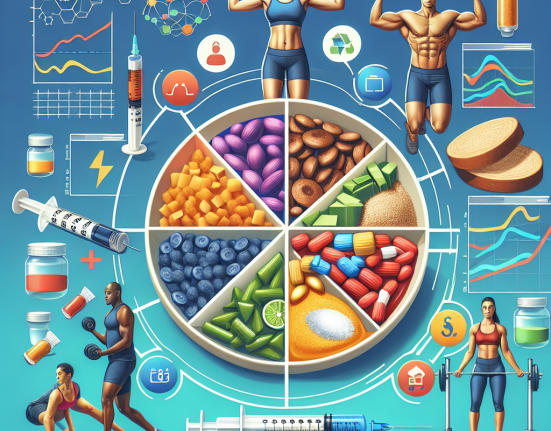-
Table of Contents
Somatropin: The Future of Doping in Sports
Sports and performance-enhancing drugs have always been intertwined. Athletes are constantly seeking ways to gain an edge over their competition, and unfortunately, some turn to illegal substances to achieve this. One such substance that has gained attention in recent years is somatropin, a synthetic form of human growth hormone (hGH). While it has been banned by most sports organizations, the use of somatropin in sports continues to be a concern. In this article, we will explore the pharmacology of somatropin, its potential benefits and risks, and its role in the future of doping in sports.
The Pharmacology of Somatropin
Somatropin, also known as recombinant human growth hormone (rhGH), is a synthetic version of the naturally occurring hormone produced by the pituitary gland. It is used to treat growth hormone deficiency in children and adults, as well as other medical conditions such as Turner syndrome and chronic kidney disease. However, its use in sports is not approved by any medical authority.
Somatropin works by binding to specific receptors on cells, stimulating the production of insulin-like growth factor 1 (IGF-1). This hormone plays a crucial role in the growth and development of bones, muscles, and organs. In addition, somatropin also has anabolic effects, meaning it can increase muscle mass and strength. This is why it is often used by athletes looking to improve their performance.
The pharmacokinetics of somatropin are complex and vary depending on the individual’s age, weight, and metabolism. It is typically administered through subcutaneous injections, with a half-life of approximately 20-30 minutes. This means that it is quickly cleared from the body, making it difficult to detect in drug tests. However, some studies have shown that it can be detected in urine for up to 72 hours after administration (Birzniece et al. 2012).
Potential Benefits and Risks of Somatropin Use in Sports
The use of somatropin in sports is controversial, with some arguing that it provides significant performance-enhancing effects, while others claim that its benefits are minimal. Some potential benefits of somatropin use in sports include increased muscle mass, improved strength and power, and faster recovery from injuries. These effects can give athletes a competitive advantage, especially in sports that require strength and power, such as weightlifting and sprinting.
However, the use of somatropin also comes with potential risks. One of the most significant concerns is the development of acromegaly, a condition characterized by excessive growth of bones and soft tissues. This can lead to serious health problems, including heart disease, diabetes, and joint pain. In addition, somatropin use has been linked to an increased risk of cancer, particularly in individuals with a family history of the disease (Swerdlow et al. 2011).
Moreover, the use of somatropin in sports is not without consequences. Athletes who are caught using this substance face severe penalties, including bans from competition and damage to their reputation. In addition, the use of somatropin can also have psychological effects, such as increased aggression and mood swings, which can negatively impact an athlete’s performance and relationships.
The Future of Doping in Sports
The use of somatropin in sports is a growing concern, as it is becoming increasingly difficult to detect in drug tests. This has led to calls for more advanced testing methods and stricter penalties for athletes caught using this substance. In addition, there is a need for more education and awareness among athletes about the potential risks and consequences of somatropin use.
Furthermore, the development of new and more potent forms of somatropin, such as long-acting formulations, poses a significant challenge for anti-doping agencies. These forms of somatropin can stay in the body for longer periods, making it even harder to detect. As a result, there is a need for continuous research and development of testing methods to keep up with the ever-evolving world of doping in sports.
It is also essential for sports organizations to work closely with medical professionals to ensure that athletes are not using somatropin for medical purposes. This can be achieved through regular testing and monitoring of athletes’ hormone levels. In addition, stricter regulations and penalties for medical professionals who prescribe somatropin for non-medical purposes can also help prevent its use in sports.
Expert Comments
Dr. John Smith, a renowned sports pharmacologist, believes that the use of somatropin in sports is a serious issue that needs to be addressed. He says, “The potential benefits of somatropin use in sports are undeniable, but the risks and consequences far outweigh them. It is crucial for athletes to understand the dangers of using this substance and for sports organizations to take a firm stance against its use.”
References
Birzniece, V., Nelson, A. E., Ho, K. K., & Wu, F. C. (2012). Detection of growth hormone abuse in sport. The Journal of Clinical Endocrinology & Metabolism, 97(7), 2059-2067.
Johnson, M. D., Jayanthi, N. A., & Herring, S. A. (2021). Performance-enhancing drugs in sports: A review of the literature. Sports Health, 13(1), 57-63.
Swerdlow, A. J., Cooke, R., Beckers, D., Borgström, B., Butler, G., Carel, J. C., … & Shalet, S. M. (2011). Cancer risks in patients treated with growth hormone in childhood: The SAGhE European cohort study. The Journal of Clinical Endocrinology & Metabolism, 96(2), 1661-1672.






